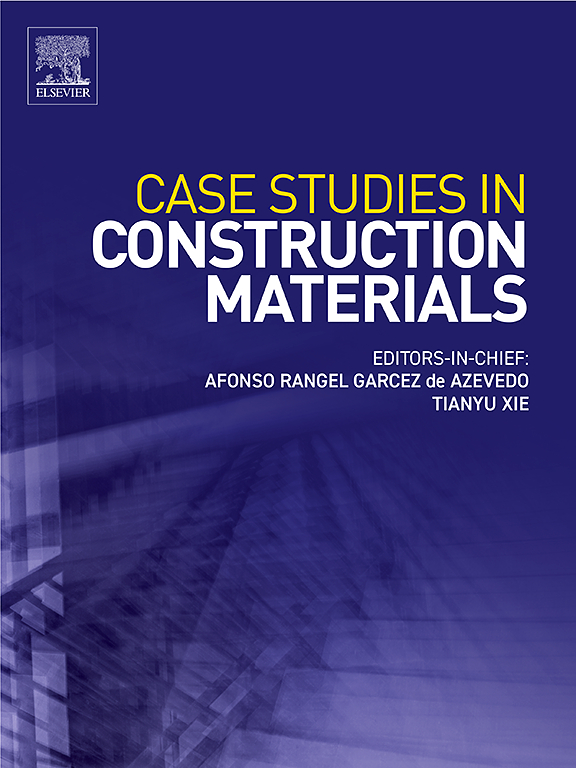Silicate refractory brick waste as quartz sand filler replacement in MOC-based composites
IF 6.5
2区 工程技术
Q1 CONSTRUCTION & BUILDING TECHNOLOGY
引用次数: 0
Abstract
This study focuses on the design and development of environmentally sustainable construction composites with an accent on the utilization of secondary raw material sources or wastes, whose secondary purpose was not discovered yet and are landfilled or downcycled only. This approach leads to a significant reduction in the environmental burden resulting from activities related to the construction industry and thus ensures its sustainability. Spent refractories are a potential candidate for this purpose. The presented experiment deals with the replacement of standard quartz sand filler by silicate refractory brick waste (SW) in magnesium oxychloride- (MOC-) based composite materials. The standard filler was replaced either partially, fully, or in excess in order to fully uncover the potential of SW as a filler in construction composites. As a matrix, MOC phase 5 (Mg3(OH)5Cl∙4 H2O), which is considered an eco-friendly alternative to Portland cement, was used, as it is known to be able to contain large amounts of filler of various origins. This way, three types of construction utilizing a waste material, which would otherwise end up landfilled, were prepared. To assess the effect of the filler replacement, a reference MOC-based composite using quartz sand as the only filler was prepared. In the SW-filled composites, the replacement ratio was 50, 100, and 150 % by weight. The introduction of SW caused an increase in compressive strength for all of the prepared samples, most significantly for composite SW50, in which the quartz sand was replaced by 50 wt%. The compressive strength of this composite reached a mean value of 101.30 MPa, which is 25 % higher than the reference composite. This value exceeds the lower compressive strength limit for a construction composite to work as a high-performance concrete by more than 20 MPa. Furthermore, all of the prepared composites show very high flexural strength values (over 30 MPa). The microstructural analysis also proved that the presence of capillary pores with a diameter range between 100 and 1000 nm, which are generally responsible for the water-induced damage in MOC-based composites was significantly decreased with the replacement of quartz sand by SW in the amount of 50 wt%.
硅酸耐火砖废料在moc基复合材料中替代石英砂填料
本研究的重点是设计和开发环境可持续的建筑复合材料,重点是利用二次原料来源或废物,其二次用途尚未发现,只是填埋或降级循环。这一办法大大减少了与建筑业有关的活动所造成的环境负担,从而确保了建筑业的可持续性。废耐火材料是这一目的的潜在候选材料。采用硅酸耐火砖废渣替代标准石英砂填料制备氯化镁基复合材料。为了充分挖掘SW作为建筑复合材料填料的潜力,标准填料被部分、完全或过量地取代。作为基质,MOC相5 (Mg3(OH)5Cl∙4 H2O)被认为是波特兰水泥的环保替代品,因为已知它能够含有大量各种来源的填料。这样,就有了三种利用废弃材料的建筑,否则这些材料最终会被填埋。为了评估填料替代的效果,制备了以石英砂为唯一填料的参考moc基复合材料。在sw填充复合材料中,替代率分别为50,100和15 %(重量)。SW的引入使所有制备样品的抗压强度都有所提高,其中最显著的是复合SW50,其中石英砂被50 wt%取代。该复合材料的抗压强度平均值为101.30 MPa,比参考复合材料提高25 %。该值比建筑复合材料作为高性能混凝土的抗压强度下限高出20 MPa以上。此外,所有制备的复合材料都显示出非常高的抗弯强度值(超过30 MPa)。微观结构分析还证明,在石英砂中添加50 wt%的SW后,moc基复合材料中出现了直径在100 ~ 1000 nm之间的毛细孔,而毛细孔是造成水致损伤的主要原因。
本文章由计算机程序翻译,如有差异,请以英文原文为准。
求助全文
约1分钟内获得全文
求助全文
来源期刊

Case Studies in Construction Materials
Multiple-
CiteScore
7.60
自引率
19.40%
发文量
842
审稿时长
63 days
期刊介绍:
Case Studies in Construction Materials provides a forum for the rapid publication of short, structured Case Studies on construction materials. In addition, the journal also publishes related Short Communications, Full length research article and Comprehensive review papers (by invitation).
The journal will provide an essential compendium of case studies for practicing engineers, designers, researchers and other practitioners who are interested in all aspects construction materials. The journal will publish new and novel case studies, but will also provide a forum for the publication of high quality descriptions of classic construction material problems and solutions.
 求助内容:
求助内容: 应助结果提醒方式:
应助结果提醒方式:


